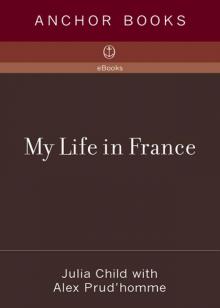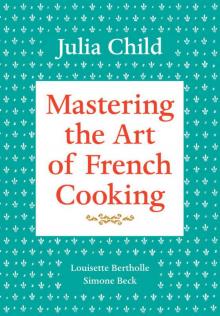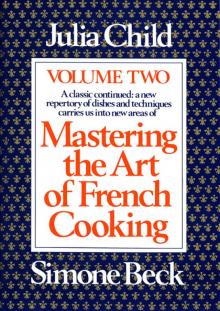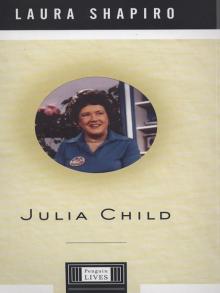- Home
- Julia Child
My Life in France Page 11
My Life in France Read online
Page 11
Les Halles at night
Working our way over to Place Pigalle, we dipped into Les Naturistes. Drinking demi-blondes at the bar, we watched about twenty young women wearing rhinestone-encrusted triangles walk across the stage in time to the music. The show lacked sparkle, so we headed off to the Left Bank, where we found a jolly nightclub called Le Club Saint-Yves. The walls were plastered with posters, postcards, and handbills from the theater world of the 1890s. The audience was made up of simple folk, all French, who were obviously having fun. What the singers lacked in voice, they made up for with personality and verve. After the club closed, at 3:00 a.m., we went on to Les Halles and walked around admiring the forts des Halles—the barrel-chested market workers—unloading crates of fresh watercress from trucks, stacking freshly cut flowers, and preparing for the day. It was cold and dark, but the vast marketplace was beautiful under splotches of yellow electric light. As dawn lightened the edges of the sky, we found ourselves at Au Pied de Cochon for a traditional bowl of onion soup, glasses of red wine, and cups of coffee. At five-fifteen, we straggled home.
FOR THE FIRST TIME since the war, strikes were legal in France, and now the Communists were having a high old time bollixing everything up—instigating fights in the Chambre des Députés, and starting little strikes here and there. By the spring of 1951, Paris was in the grip of a debilitating general strike led by the Confédération Générale du Travail, or CGT, the biggest holding company for the unions. The CGT was said to be Communist-dominated, and it had cynically prodded gas, electricity, telephone, and dockworkers to strike under the name of “increasing workers’ wages” (which was a legitimate need), but really for the CGT’s own political gain (which was not).
As a result, there were hardly any buses or metros running, little electricity, and just a whisper of gas for our stove. (To avoid an explosive mixture of air and gas seepage, they continued to feed the tiniest bit of gas into the pipes.) Cooking became a challenge. Even a simple dinner of lamb chops (forty-five minutes), boiled potatoes (over one hour), canned peas (ten minutes), and grapefruit suddenly wasn’t so simple. My ten-day supply of cat food came unfrozen in the icebox. And when we gave a dinner party for six, I had to do most of my cooking on the electric stoves in the basement of the Cordon Bleu.
As many streets still relied on gaslit lanterns, the dimming effect was reminiscent of a wartime blackout. Driving at night was hazardous, as pedestrians were invisible, bikes looked like fireflies, and other cars would dazzle you when they flashed on their headlights every few seconds. The few metros that did run were jammed to impossibility, and it took from two to four hours to make a metro trip that usually took forty minutes.
Paul and I initiated the Blue Flash Bus Service, picking up and dropping off embassy staff all over Paris—at Port de Clichy, Gare de Lyon, Nation, and Commerce. We’d never seen such traffic. Half of it was made up of bicycles; the rest was army trucks being used as commuter buses, and any kind of vehicle that could be dragged out of scrap yards and root cellars and made to run on homemade fuel.
During this unsettled period, Paul became preoccupied with two subjects: the fact that most people didn’t believe in the possibility of flying saucers, and the fact that the U.S. wasn’t doing enough to prepare Western Europe for a Russian invasion. In both cases, he claimed, “people need to see the thing in order to believe it.” Paul and Charlie—the sons of an electrical engineer and a bohemian singer—shared a dual nature: they were extremely practical and could build you a house or wire your lamp without batting an eye; but they were also mystical, enjoyed the mumblings of fortune-tellers, and believed in the possibility of ghosts and flying saucers.
I did not share this trait. I was more concerned with the problems in front of me, such as how to get around Paris during the strikes, where to find the best asparagus, and how to further my program of self-education.
I had been trying to read Serious News Articles—a Harper’s essay about post-war England, a Fortune article about free trade—and to remember their facts and lines of argument in order to discuss them intelligently at dinner parties. But it was a struggle. My sievelike mind didn’t want to lock away dates and details; it wanted to float and meander. If I mixed all those facts and theses up with a little gelatine and egg white, I wondered, would they stick together better?
II. HOME LEAVE
DORT AND IVAN were engaged, and the wedding would be held in New York, in June 1951. She blossomed like a peony around him, and I was supportive of their union. But it was no secret that Big John was not wildly enthusiastic about it. Just as I had done, Dorothy had chosen someone completely different from our father to be her life-mate.
We hosted a farewell jamboree for them at 81 Roo de Loo. The pièce de résistance for the evening was a mammoth galantine de volaille, which took me three days to create and had been adopted from a recipe in Larousse Gastronomique. First you make a superb bouillon—from veal leg, feet, and bones—for poaching. Then you debone a nice plump four-pound chicken, and marinate the meat with finely ground pork and veal strips in Cognac and truffles. Then you re-form the chicken, stuffing it with a nice row of truffles wrapped in farce and a fresh strip of pork fat, which you hope ends up in the center. You tie up this bundle and poach it in the delicious bouillon. Once it is cooked, you let it cool and then decorate it—I used green swirls of blanched leeks, red dots of pimiento, brown-black accents of sliced truffle, and yellow splashes of butter. The whole was then covered with beautiful clarified-bouillon jelly.
This exquisite dish took time, but it was great fun. The hardest part was arranging the decorations on top, which in my color-pencil rendering looked meager and childlike. Luckily, that nice Mr. P. Child came to the rescue with a stylish design. The final result, I must say, was magnificent—a suitably grand send-off for the beaming bride- and groom-to-be.
SINCE 1944, Paul and I had spent four and a half years out of the United States and two and a half years in it. On May 4, we would board La Liberté, bound for New York, and excited to see our distant homeland.
Before we left Paris, and with a lump in our throats, we had decided to sell the Blue Flash. The car had served us well—carrying American ham and Burgundy wine and Italian spaghetti and Swiss typewriters and Maine lobsters. But it had a wheeze in every pipe, busted springs, peeling chrome, and a tick in the motor, and was in need of two hundred dollars’ worth of repairs. We ordered a new car, which we’d pick up in the States.
In the meantime, Chef Bugnard had told me that, despite my exam debacle, I was well qualified to be chef in a maison de la haute bourgeoisie. It was a nice compliment, but I was no longer satisfied with being “just” an accomplished home cook. Cooking was so endlessly interesting that I wanted to make a career of it, though I was sketchy on the details. My plan was to start by teaching a few classes to Americans in Paris. My guiding principle would be to make cooks out of people, rather than gobs of money: I wouldn’t lose money, but I’d dedicate myself to the teaching of gastronomy in an atmosphere of friendly and encouraging professionalism.
Still, if Freddie and I were ever going to open the Mrs. Child & Mrs. Child restaurant, I’d need a diplôme from the Cordon Bleu. This meant retaking the final exam.
When I made inquiries, Madame Brassart once again failed to respond. Fed up, I wrote, “It surprises me to see you take so little interest in your students.” Once again, Chef Bugnard spoke to her on my behalf, and once again a date for my test was miraculously set. This time, instead of steeping myself in challenging recipes, I simply memorized the dishes in the Cordon Bleu’s little booklet. When the day came, I took the exam in my own kitchen at Roo de Loo. It consisted of a very simple written section followed by the preparation of a basic meal for Bugnard and my friend Helen Kirkpatrick. I passed.
In September, after we had returned from the States, I finally received my diploma. It was signed by Madame Brassart and Chef Max Bugnard, and had been backdated to March 15, 1951! At last, Julia McWilliams Child coul
d say that she was a full-fledged graduate of Le Cordon Bleu, of Paris, France.
MEANWHILE, DORT and Ivan had a lovely wedding at the St. Thomas Church in New York City. After the ceremony, Paul and I jumped aboard the Chief in Pennsylvania Station and crossed the familiar-unfamiliar U.S.A. to California—where the weather, the flowers, and the trees were always wonderful, everybody had a Cadillac, and where, as Candide put it, “everything was for the best in this best of all possible worlds.”
In Pasadena, we were absorbed into a seemingly endless stream of cocktail parties, lunches, and dinners. The atmosphere of ease and charm there felt both intimately familiar and strangely foreign. I did my best to remain polite and positive during our two-week stay. So did Paul, who nearly strained a muscle trying to create good feelings while staying true to his own convictions. He had to bite his tongue when my father’s friends would casually scorn President Truman, Jews, Negroes, the United Nations, or “all those Phi Beta Kappas” in Washington.
Back in New York we picked up our brand-new car, a gleaming black Chevrolet Styleline Deluxe Sedan, model 2102, which we promptly christened La Tulipe Noire. The Tulipe swept us north along the interstates, to Charlie and Freddie’s cabin in Maine, where the car’s new tires and fenders were immediately christened with some good old-fashioned sticky brown mud. Over the next week, we managed to sun and swim and work California and its discontents out of our systems. While Paul helped Charlie construct a new road, fell trees, and build a new room for the cabin, I busied myself making bread and bouillabaisse in the makeshift kitchen. It was a little slice of heaven. In mid-July we celebrated my thirty-ninth birthday (a month ahead of the actual date) with a picnic on the stony beach, where my niece Rachel presented me with a gloriously silly hat, decorated with wildflowers, seashells, and Slinkys.
Finally, it was back to New York and onto the Nieuw Amsterdam, for an uneventful return trip to France. We arrived in Le Havre on July 27.
After driving to Rouen, we stopped in for lunch at La Couronne, where we ordered exactly the same meal that we’d had on my first day in France, more than two and a half years earlier: portugaises (oysters), sole meunière, salade verte, fromage blanc, and café filtre. Ah me! The meal was just as sublime the second time around, only now I could identify the smells in the air quicker than Paul, order my own food without help, and truly appreciate the artistry of the kitchen. La Couronne was the same, but I had become a different person.
III. LA CHASSE
IT WAS la morte-saison, and an estimated one million Parisians had evacuated the city for their summer vacances. All the decent restaurants were boarded up. So were the laundry places. We had intended to have our kitchen repainted, but could not find anyone to do the work for us. Paul spent an evening on home improvements—patching holes in the Cordova-leather walls in the dining room, hanging a lovely nude painted by Charlie in our bedroom, then using the lumber from the nude’s packing case to add a one-foot extension onto the end of our bed. At last, I could fit my size 12 feet comfortably under the covers, rather than have them sticking out like a pair of gargoyles.
The locals were gone, but the streets of Paris were thick with Youth from all over the world. Many of these were Boy Scouts, returning from a worldwide Jamboree in Austria. One of them, a fifteen-year-old cousin of mine named Mac Fiske, had lunch, dinner, and a bath at our place.
“What do Boy Scouts like to eat, anyway?” I asked.
“A lot,” Paul quipped. And he was right. Mac had the appetite of a Russian wolf. As he departed, Mac said: “You’re such nice people! You’re the only people I seen around here who have a lot to eat all the time!”
IN SEPTEMBER, the weather turned rainy and cool and satisfyingly beautiful, with big shadowy thunderclouds alternating with bright shafts of sunlight. The Tulipe Noire still wore its New York license plates, but the rain washed the New England mud and grit out from behind its ears. Paul was madly busy at the USIS, arranging a fall show of Frank Lloyd Wright’s work and going to a million and one official functions.
In October, we were at a cocktail party at Averell Harriman’s house, where I noticed he’d hung photographs of some of his heroes, like General Sherrill, on the wall. This gave me a thought: if I ever went into the cookery business, it would help to have photos of some of my heroes on display—Carème, Escoffier, and, naturellement, Bugnard. One should always prepare for the future!
Autumn was hunting season, “la chasse,” a serious passion in France, and suddenly wild game of every pelt and feather appeared in the marketplaces. Wild hares and rabbits hung whole; haunches of elk, wild boar, and venison were presented with hoof and fur intact. The shoppers insisted on this, Bugnard explained, for how would you know what you were buying if the game was all skinned and wrapped up?
I was eager to try these delicacies, and was thrilled when Bugnard instructed me on where to buy a proper haunch of venison and how to prepare it. I picked a good-looking piece, then marinated it in red wine, aromatic vegetables, and herbs, and hung the lot for several days in a big bag out the kitchen window. When I judged it ready, by smell, I roasted it for a good long while. The venison made a splendid dinner, with a rich, deep, gamy-tasting sauce, and for days afterward Paul and I feasted on its very special cold meat. When the deer had given us its all, I offered the big leg-bone structure to Minette. “Would you like to try this, poussiequette?” I asked her, laying the platter on the floor. She approached tentatively and sniffed. Then the wild-game signals must have hit her central nervous system, for she suddenly arched her back and, with hair standing on end, let out a snarling groowwwwllll! She lunged at the bone and, grabbing it with her sharp teeth, dragged it out onto the living-room rug—luckily a well-worn Oriental—where she chewed at it for a good hour before stalking off. (Even in such intense circumstances, she rarely laid paw on bone, preferring to use her teeth.)
Game birds are especially popular in autumn. You see gaggles of pheasants and grouse, woodcocks with their long thin bills, partridges, and wild duck in the marketplace of every village, hamlet, and town. It seems the French will eat almost any feathered flying creature, from thrushes to swallows to blackbirds and larks (called alouettes, as in the song “Alouette, Gentille Alouette”); on several occasions we ate a tiny but delicious avian called un vanneau, or lapwing.
Partridge was one of my favorite discoveries. During one early-morning exploration of Les Halles, Chef Bugnard stopped at a friend’s stall and, picking up a partridge, said, “Here you see a perdreau.” The generic name for partridge is perdrix, but a young roasting bird is a perdreau. He decided to demonstrate how to make the famous perdreau rôti sur canapé, a roast partridge on a crouton of its own chopped liver.
Bending the tip end of the bird’s breastbone, he said, “Feel that. It bends a little at the end.” With some difficulty at first, because of the feathers, I felt the breastbone. It did indeed have about half an inch of flexibility at the tail end. The bird’s legs and feet were also subjected to Chef’s inspection: if there was a claw above the back of the heel, it was mature; youthful perdreaux have but a nubbin where the eventual claw will be, and their legs are not raddled by age. The feathers, too, tell something, since those of the young have a bit of white at the very tips.
Picking up a mature partridge, a perdrix, he said, “When you feel a rigid bone from neck to tail, you have maturity.” A perdrix wants braising in cabbage, he said, and perdrix en chartreuse is the classic recipe.
At the Restaurant des Artistes, on Rue Lepic, Chef Mangelatte offered a beautifully roasted perdreau nesting on a toasty crouton, surrounded by sprigs of very fresh watercress and a small haystack of just-cooked crisp shoestring potatoes. Its nicely browned head, shorn of feathers but not of neck or beak, would be curled around its shoulder, and its feet, minus claws, folded up at either side of its breast. It’s hardly an American presentation, but a game-lover wants to see all those telltale appendages, just to be sure it’s really a perdreau on the platter.
T
he patron beautifully and swiftly carved off legs, wings, and breast, and served each person an entire bird, including the back, feet, head, and neck (when eating game, you nibble everything). He had placed the breast upon the canapé, an oval-shaped slice of white bread browned in clarified butter, topped with the liver—which had been chopped fine with a little fresh bacon—then mixed with drops of port wine and seasonings before a brief run under the broiler. The sauce? A simple deglazing of the roasting juices with a little port and a swirl of butter. Delicious!
The bird itself is smallish, with a different whiff, a winey brown promise of rosy dark meat that is also tantalizingly yet subtly gamy. You want it hung just long enough so that when you flare the breast feathers you begin to smell game; then you pluck it and roast it at once.
This is the kind of food I had fallen I love with: not trendy, souped-up fantasies, just something very good to eat. It was classic French cooking, where the ingredients have been carefully selected and beautifully and knowingly prepared. Or, in the words of the famous gastronome Curnonsky, “Food that tastes of what it is.”
IV. SIMCA AND LOUISETTE
ONE DAY IN NOVEMBER 1951, we had a Gourmette, a Madame Simone Beck Fischbacher, to lunch at Roo de Loo. We talked about food, of course. She was a tall, dashing, vigorous française of about forty-two, with shoulder-length blond hair parted on the side, pale milky skin, high cheekbones, dark-rimmed glasses, and firmly held convictions.

 Julia's Kitchen Wisdom
Julia's Kitchen Wisdom My Life in France
My Life in France Mastering the Art of French Cooking, Volume 1
Mastering the Art of French Cooking, Volume 1 Mastering the Art of French Cooking, Volume 2
Mastering the Art of French Cooking, Volume 2 Laura Shapiro
Laura Shapiro